17+ SAMPLE Production Control Plan
-
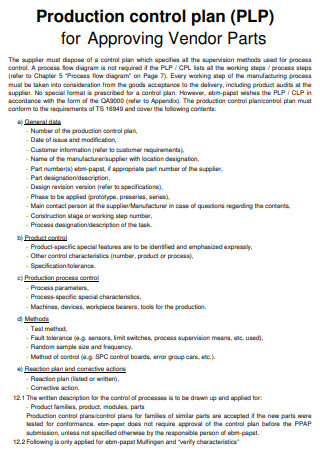
Production Control Plan for Approving Vendor
download now -
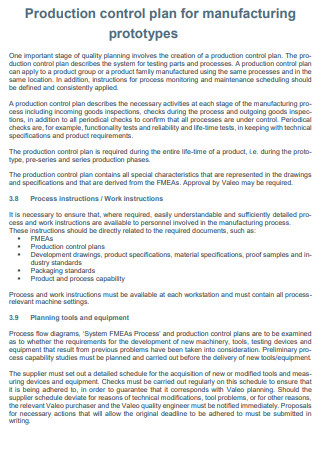
Production Control Plan for Manufacturing Prototypes
download now -
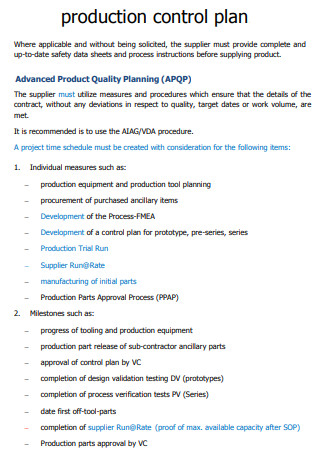
Production Control Plan
download now -
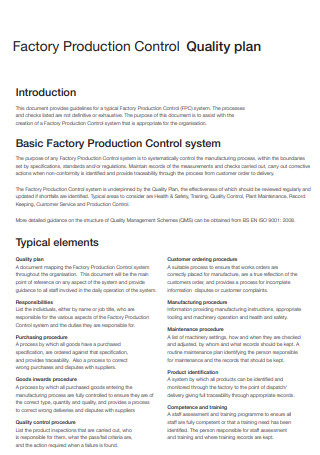
Production Quality Control Plan
download now -
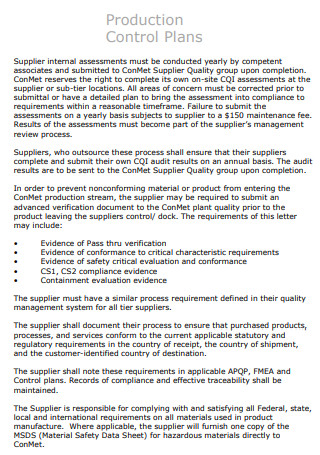
Sample Production Control Plan
download now -
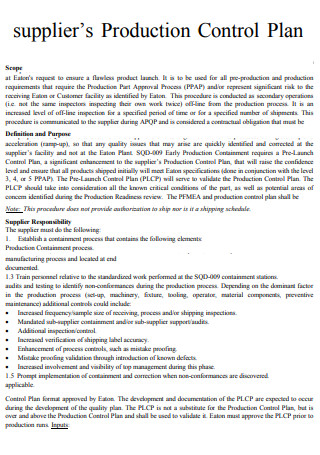
Supliers Production Control Plan
download now -
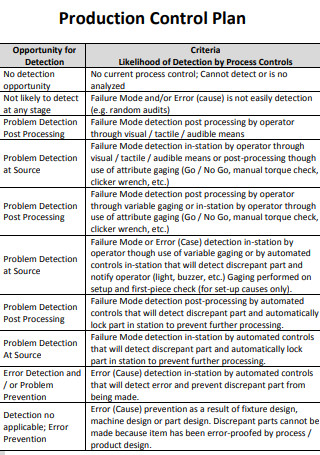
Simple Production Control Plan
download now -
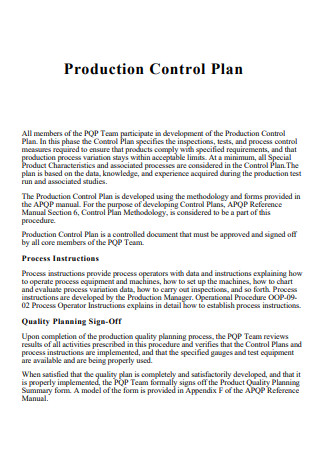
Basic Production Control Plan
download now -

Automotive Production Control Plan
download now -
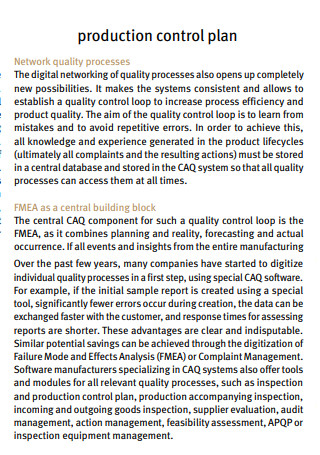
Professional Production Control Plan
download now -
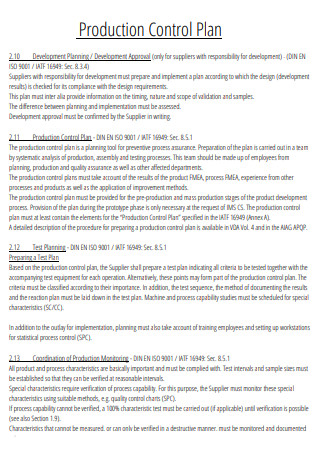
General Production Control Plan
download now -
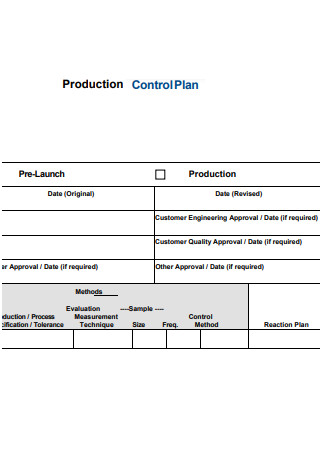
Production Control Plan Worksheet
download now -
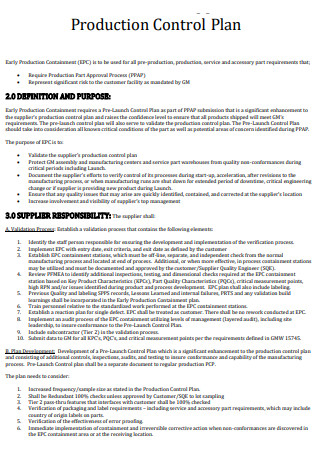
Early Production Control Plan
download now -
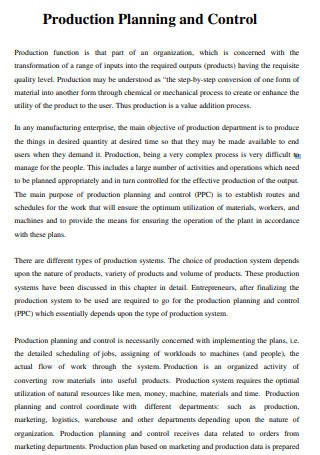
Production Control Planning
download now -
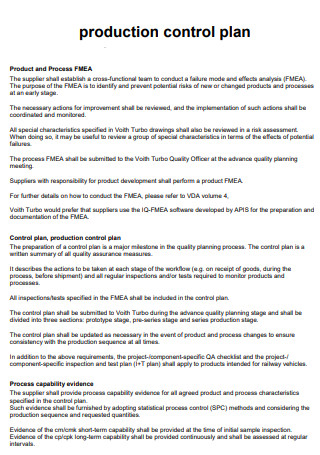
Standard Production Control Plan
download now -
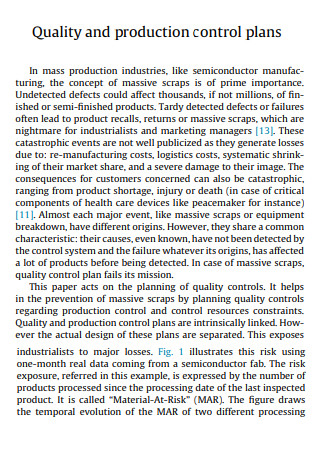
Scrap Production Control Plan
download now -
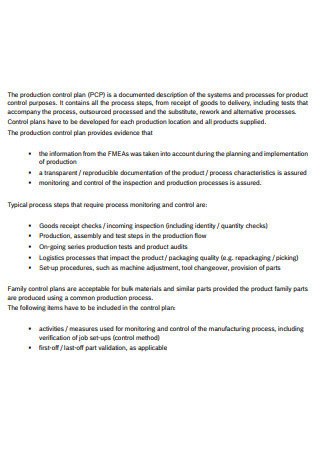
Production Control Plan Template
download now -
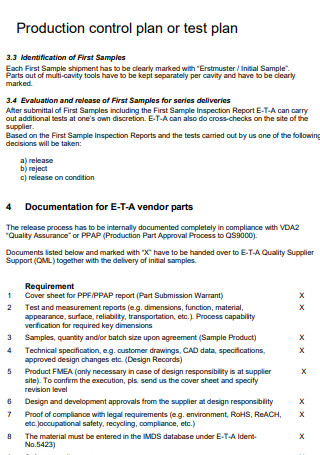
Production Process Product Control Plan
download now
FREE Production Control Plan s to Download
17+ SAMPLE Production Control Plan
What Is a Production Control Plan?
What Is a Production Control?
Functions Involved in Production Control:
What Are the Objectives of Production Control?
6 Steps in Production Control:
How Do You Create a Production Control Plan?
FAQs
What is the difference between quality plan and control plan?
What Are the Benefits of Production Control?
What are the important decisions that must be made during production planning?
What is the main factor affecting production control?
How can production scheduling be improved?
Additionally, a production control involves the use of various control techniques to secure the production performance per plans. Coordinating men and materials and machines are the task of production control. With an effective Production Control Plan, it becomes easier to designate each task, making everything run smoothly.
What Is a Production Control Plan?
Production Control Plan is a predetermined process that plans, manages, and controls the allocation of human resource, raw material, and machinery to achieve maximum efficiency. On the other hand, production planning is a sequence of steps that inspires manufacturers to work better and optimize their production process in the best possible manner. This helps manufacturers work smarter by efficiently managing internal resources to meet customer demand. In addition, production control ensures that the production team can attain the needed production target, optimum utilization of resources, quality management, and cost savings.
For efficient and economical function in a manufacturing unit of an organization, it is important to integrate the production planning and control system. Production planning and subsequent production control follow adaption of product design and finalization of a production process. Moreover, production planning and control address a fundamental problem of inventory management, low productivity, and resource utilization. Production planning is required for scheduling, dispatch, inspection, quality management, inventory management, supply management and equipment management.
What Is a Production Control?
The production control is the operation of management which plans, directs, and controls the material supply and processing activities of a business so that particular products are produced by specified methods to meet an approved sales program. It ensures that activities are carried out in such a way that the available labor and capital are used in the best way. The term production control to include the following:
- The production plan or planning
- Scheduling
- Machine, labor utilization, or dispatching
- Stock control
- Manufacturing control or routing
- Progress
Production control may be defined as the process of planning production in advance of operations; establishing the exact route of each individual item, part of assembly; setting and finishing dates for each important item, assembly and the finished products, and releasing the important orders as well as initiating the required follow-up to effectively have a smooth functioning of the enterprises.
Production control is the art and science of making sure that all which occurs is in accordance with the rules established and the instructions issued. Hence, production control regulates the orderly flow of materials in the manufacturing process from the raw material stage to the finished product. It also aims at achieving production targets, increased profits through productivity, optimum use of available resources, better and more economic goods and services, etc. An effective production control system requires reliable information, sound organization structure, a high degree of standardization and well-trained personnel for its successful operation.
Furthermore, production control utilizes different type of control techniques to achieve optimum performance out of the production system as to achieve general production planning targets. Therefore, objectives of production control are as follows: regulate inventory management, organize the production schedules, and optimum utilization of resources and production process.
Production control cannot be same across all the organization. Production control is dependent upon the nature of production (job-oriented, service oriented), nature of operation, and size of operation. Production planning and control are vital for customer delight and general success of an organization or a company.
Functions Involved in Production Control:
The following factors are involved in the practice of production control:
What Are the Objectives of Production Control?
The success of a business or an organization greatly depends on the performance of its production control department. The production control department generally has to perform the following functions:
- Provision of raw material, equipment, machines and labor.
- The resources are used in the best possible manner in such a way that the cost of production is minimized and delivery date is maintained.
- To organize production schedule in conformity with the demand forecasts.
- To perform inspection of semi-finished and finished goods and use quality control techniques to ascertain that the produced items are of required specifications.
- Determination of economic production runs with a view to reduce setup costs.
- Proper co-ordination of the operations of various sections/departments responsible for production.
- To ensure regular and timely supply of raw material at the desired place and of prescribed quality and quantity to avoid delays in production.
- It is also responsible for product design and development.
Hence, the fundamental objective of production control is to balance and control the different operations of production process such a way that orderly flow of material is made sure at different stages of the production and the items are produced of in right quantity, right quality, at the right time with minimum efforts and cost.
6 Steps in Production Control:
Out of these steps involved in production control, the first three steps relate to planning; the fourth relates to execution of plan and; the last two refer to the control aspect of planning. Production control involves the following steps:
Step 1: Planning
The planning department will receive the whole information from management about the quantity to be produced and the dates when delivery has been promised to customers for planning of productive operations in detail. Also, the planning department will get the essential engineering and drawing specifications from the engineering department.
Step 2: Routing
The objective of routing is to find out the best and the cheapest sequence of operations. Routing involves the determination of the path that work shall follow and the order in which various operations will be carried out. While preparing the route card, it must be kept in mind that machines in the plant are operated at their full capacity; and manpower and other facilities are best utilized.
Step 3: Scheduling
Scheduling is the determination of the time that should be required to perform each operation and also the time necessary to perform the entire series, as routed, making allowance for factors concerned. In preparing schedules, the persons concerned will need to take into consideration the different types of orders on hand and the dates by which their completion has been promised. Moreover, since scheduling involves the preparation of a time-table, indicating the total time needed for the manufacture of a product as also the time expected to be spent at each machine and process, some orders may be such as will require over-time work; because completion is not possible according to the delivery dates set for them, in the regular course of production.
Step 4: Dispatching
Dispatching literally means sending something towards a specific destination. It means taking all such steps, as are essential to implement the program of production outlined per routing and scheduling steps. To be specific, dispatching refers to:
- Procurement of necessary tools, jigs and fixtures; before they are actually required by the workers.
- Giving workers the important work orders, instructions, or drawings for initiating the work.
Step 5: Follow-Up or Check Out the Progress
Follow-up is the control aspect of production planning and control. This involves taking steps to check up whether work proceeds based on the plans and how far there are discrepancies from standards; and also taking necessary corrective steps to set things in order.
Step 6: Inspection
Inspection is the quality control aspect of production planning and control. This ensures that goods produced are of the right quality. The inspectors or quality assurance team may inspect materials, semi-finished, and finished products either at the work bench or in special laboratories or testing rooms.
How Do You Create a Production Control Plan?
There are so many ways to create a production control plan and these are the direct steps to follow:
Step 1: Set Up a Multi-Functional Team
If someone from the quality department works on this alone, there are two issues:
He/she might miss some crucial points, fail to assess criticality properly. Or sending a finished plan over the wall is usually ineffective if the people who will need to apply it were not involved in designing that plan. At the very least, involve manufacturing, a process engineer, and someone in close contact with the customers. If this product was developed in-house, bring in R&D. Purchasing should also be involved, at least when the discussion covers incoming QC on components.
Step 2: Review and Confirm the Flow Chart
Having a good idea of the process steps is a must. Once the process flow chart and plant schematic have been drafted, they must be confirmed by an on-site inspection for accuracy and completeness.
Step 3: Review and Confirm Special Characteristics
With a view of the whole and a good understanding of what the customer considers very essential, the team can decide what steps are critical vs. very important vs. less important. At this stage, a process Failure Modes and Effects Analysis (FMEA) can help a lot in pointing to high risks that need to be addressed. It is always a big input.
Step 4: Assess and Confirm the Control Method
The team decides what controls make sense based on the criticality of the steps, and on the risks perceived. The factory should spend resources where they are most needed. Show them how to control risks in an effective manner, or they will be much less likely to sustain this approach over time.
Step 5: Evaluate the Sampling Method
Checking a point on 100% of pieces might take much more effort than “1 in 10 parts”, for instance.
Step 6: Verify the Effectiveness of the Measurement System
Are non-conforming parts really detected? Are some conforming parts put aside? This is an entire topic on its own, and it deserves some attention. Checking for the sake of checking is worthless.
Step 7: Confirm the Person-In-Charge
Who will be primarily accountable for the application of the process control plan, and its adaptation over time as new problems, new risks, and new customer requirements appear?
Step 8: Confirm the Escalation Process
To whom does the team go to when a decision needs to be made by a higher level of management?
Step 9: Write Control Plan Draft
Fill out the remaining columns. Train the people. Adapt the operators’ and inspectors’ work instructions. Assess, at least during a pilot run or a mass production batch.
Step 10: Review and Modification
It is a draft and needs to change. Particular controls might be overly burdensome, badly specified, lacking clear criteria, and so on. Likewise, new issues might appear, calling for extra controls.
Step 11: Control the Implementation in the Middle to Long-Run
There are good chances the plan will be efficient if there is enough buy-in in the team, if there are periodic audits, if it has been translated into clear work instructions, and if top management applies pressure to keep this in place.
FAQs
What is the difference between quality plan and control plan?
A Quality Plan helps you schedule all of the tasks needed to ensure that your project meets the needs of your customer. It consists two parts; the Quality Assurance Plan lists the independent reviews needed and the Control Plan lists the internal reviews needed to meet your quality targets.
What Are the Benefits of Production Control?
The benefits of production planning and control include improved organization for regular and timely delivery, production cost savings that improve the bottom line, better supplier communication for raw materials procurement, reduced waste of resources, reduced investment in inventory, reduced production cost by increasing efficiency, and smooth flow of all production processes
What are the important decisions that must be made during production planning?
There are four important decisions that must be made in production planning. They consist the type of production process that will be used, site selection, facility layout, and resource planning.
What is the main factor affecting production control?
The factor that affects production control is the volume of production. The amount of production planning is determined by the volume of operation and nature of manufacturing process it helps to reduce manufacturing cost.
How can production scheduling be improved?
There are a few effective production planning strategies that you can instantly apply to your manufacturing plant: use the right forecasting method, implement better inventory control, understand your production capacity, use an automated production planning system, and avoid delays with equipment and machine maintenance.
Production—the creation of products and services, is an essential function in every firm. Production turns inputs—such as natural resources, human resources, raw materials, and capital, into outputs, which are products and services.
There will be few rush orders as production takes place per schedule. That being said, there will be less overtime work in the company, compared to other firms in the same industry. Promised delivery dates are kept, production flows per scheduled time. This gives confidence in the traveling salespersons of the firm to set delivery date. Timely delivery and customers’ confidence, improve customer-relations and sales. Management is consistently kept informed on the current position of all work-in-process and on equipment and personnel requirements for the next few weeks ahead. Therefore, workers can be informed in advance of possible lay-offs or transfers. Hence, belated purchase of equipment and materials can be avoided and idleness of men and machine are eliminated.
